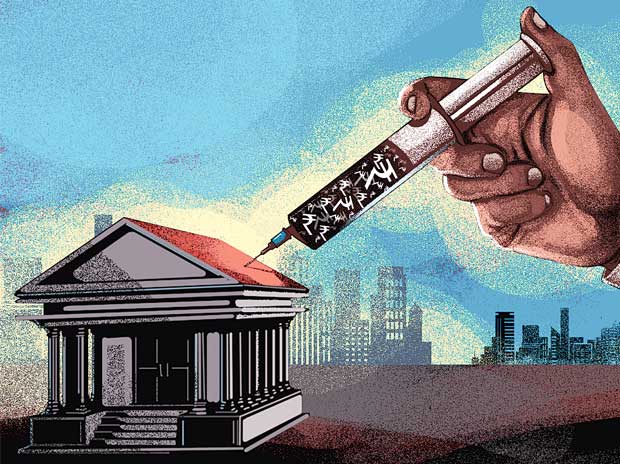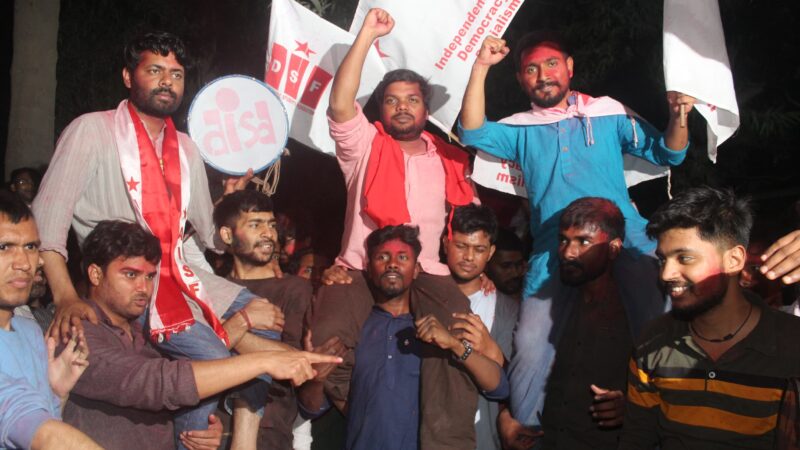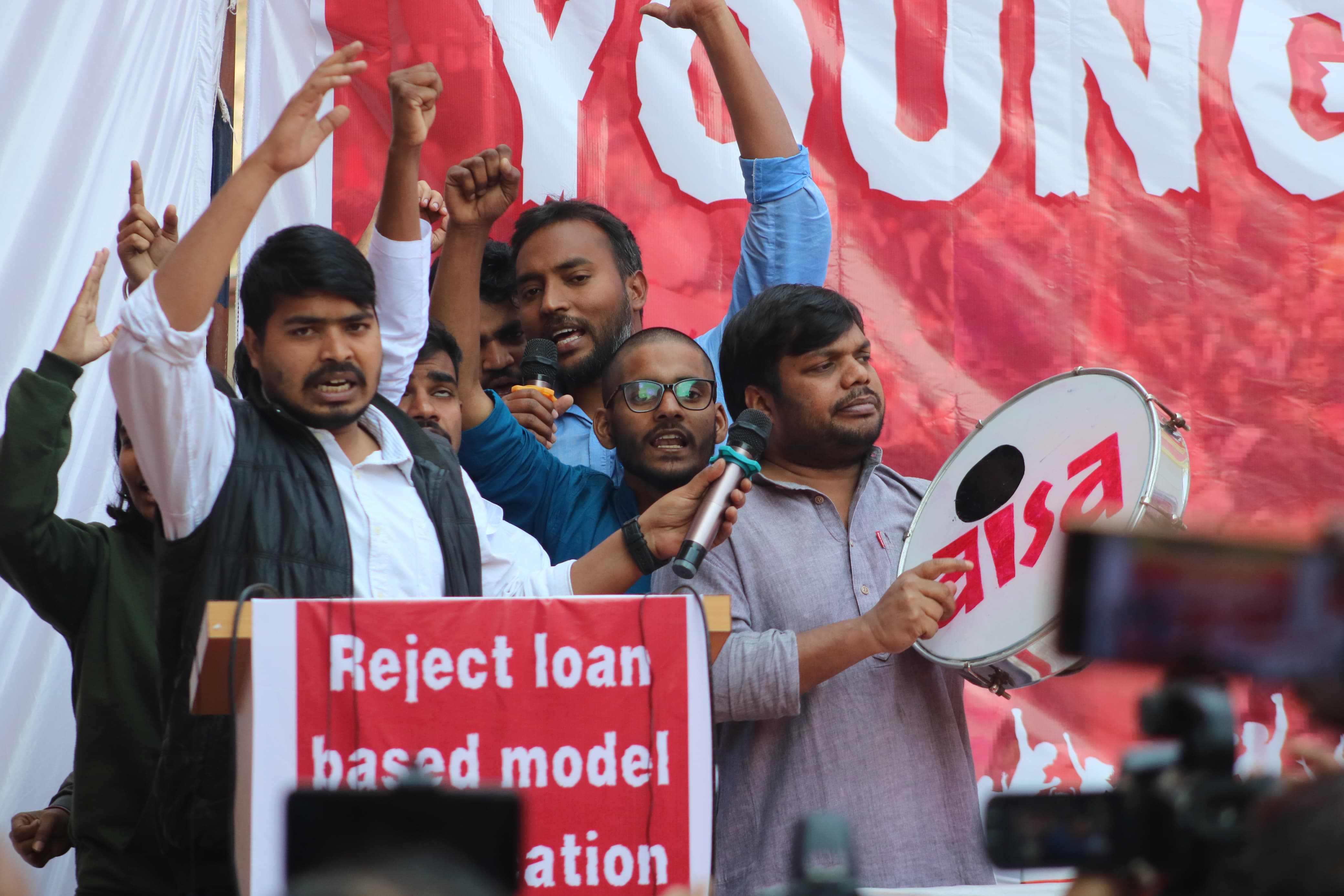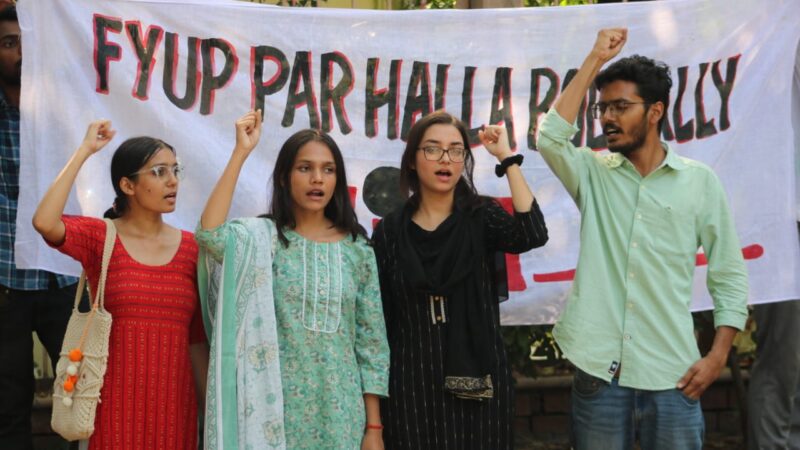Demonetisation, GST & Bank Recapitalisation
 Pauperising the masses and pampering the big corporates – this in a nutshell is the unfolding economic agenda of the Modi regime. We have witnessed this in the recent policy level assaults on Indian economy and democracy – through the triple trauma of demonetization, Goods and Services Tax (GST) and bank recapitalization to cover up bad loans.
Pauperising the masses and pampering the big corporates – this in a nutshell is the unfolding economic agenda of the Modi regime. We have witnessed this in the recent policy level assaults on Indian economy and democracy – through the triple trauma of demonetization, Goods and Services Tax (GST) and bank recapitalization to cover up bad loans.
Bad Loans-Big Bank Loot: According to the data from several credit rating agencies, total “stressed assets” with public sector banks has surged to a mammoth Rs. 15 to 20 lakh crore. This includes non-performing assets, restructured and waived of loans. In the last three years of Modi government, the rate of recovery of bad loans has also drastically fallen from 22% to 10%. Modi regime has already waived off Rs. 2.8 lakh crore of public money as bad loans for the corporates making it the largest scam in independent India surpassing the 1.76 lakh crore 2G scam! And pliant media is stoically silent about it. It is shameful that both the Government and the Reserve Bank of India (RBI), the regulator of banking sector, have maintained a shameful secrecy about the list of wilful corporate defaulters. After being repeatedly ordered by the Supreme Court, RBI in April 2017 submitted a list of wilful corporate defaulters of unrecovered loans exceeding Rs. 500 crores. However, the list was submitted in a sealed cover and the Supreme Court was urged NOT to reveal the names! In contrast, the farmers who fail to return their crop loan of mere Rs 15000 or so due to low minimum support price or hostile climate are named and shamed by the same banks by posting their names and photo’s on the bulletin boards, pushing them to humiliation and death.
Demonetization Disaster: More than one full year has elapsed since Narendra Modi’s dramatic announcement of demonetization. At that point, people were assured that the pain would be temporary and that it was a necessary sacrifice to win the war on corruption, black money and terrorism. But after one year of the demonetization disaster, the country can only feel cheated and devastated by the hurtful experiences of real life. What began as temporary disruption has paved the way for a longer-term disaster.
What has demonetization really ‘achieved’? The “Official” figures speak for themselves: According to the RBI’s own figures, almost all the money (99%) that was supposed to be in circulation or private hands came back. If this included any black money it has all become white! Fake currency is still around. A miniscule amount of fake notes was confiscated. The new notes have proved as vulnerable to counterfeits as their old avatars; the incidence of terrorism has certainly not gone down; and if recent reports of corruption from BJP-ruled states, the thriving phenomenon of crony capitalism within Modi’s ‘power parivar’ (be it the now closed Temple Enterprise of Amit Shah’s son or the ‘think-tank business’ of Shourya Doval, son of National Security Advisor Ajit Doval) and the explosive details of offshore operations of the Indian super-rich (individuals as well as companies, including MPs and Ministers of the BJP) as revealed first in the Panama Papers and most recently in the Paradise Papers are anything to go by, corruption, tax evasion and black money have only got more deeply entrenched.
On the anniversary of note ban, the Union Law Minister even went on to claim that prostitution has nosedived after demonetization! Though the Government, even now, disgracefully and desperately, is trying to shift goalposts about imaginary “benefits” of demonetization with all these outlandish and ridiculous claims – the massive cost common people paid post note ban are real! We have witnessed at least 150 deaths after this policy disaster, GDP growth rate fell from 7% (in Jan-Mar 2016) to 6.1% (in Jan-Mar 2017) and further to 5.7% in Apr-Jun 2017. CMIE has calculated 15 million job loss during the post-demonetization first four months of 2017! Formal employment has declined from 928.7 lakh in Jan-April 2016 to 861.2 lakh in Jan-April 2017. Indeed, our entire informal sector, small and medium business have been pushed into a massive recession, wiping out savings and livelihoods of vast sections of our working population. The entire data for these sectors are yet to be captured and publicised. Once captured, the GDP figures will be further revised downwards.
Vicious Cycle of Loss for Common Man and A Virtuous Cycle of Corporate Loot & Bonanza
When demonetization was announced, the banks were reeling under twin crisis of liquidity and credibility under the weight of massive NPA and bad loans. Through demonetization and forced deposition of the common people’s hard earned money, the liquidity and capital base of the banks were restored, again to make them credit worthy for corporates. What came next is a bag of new tricks continuing the “vicious cycle of economic assaults” on common people and “virtuous cycle” for looter corporates.
Bank Recapitalisation: The so called big bang booster of bank recapitalisation is nothing but the taxpayer bailing out India’s public sector banks whose capital base stands eroded because of mounting loan defaults mostly by 50 large corporate groups. The recapitalisation move planned by the Modi government planned to generate 2.11 lakh crore to infuse liquidity into banking system so that fresh loans could be given to the corporate and industrial sector. However the process of generating the 2.11 lakh crore again exposes that the common people has to bear the brunt of corporate default. Firstly, Rs 18,000 crore will be made available through the budgetary provisions, whereby the government will directly use tax payers money to buy shares in the banks and raise their capital. Secondly, govt will encourage banks to raise Rs 58,000 crore from the market. Thirdly and most interestingly, the main chunk – Rs. 1.35 lakh crore – of the whole scheme is expected to come from the so-called “Recapitalisation bonds”. The initiation for generating the money for “Recapitalisation bonds” starts with government offering these bonds to the banks for subscription. The banks, flush with liquidity after demonetisation, will use this liquidity to buy the bonds from the govt. The govt, in turn, will use the same amount to buy new shares in Public Sector Banks and thus infusing capital for them to provide fresh loans for corporates. What a fantastic “accounting hocus-pocus” using common man’s money to fuel the next cycle of ‘corporate loans-wilful default-bad loans-recapitalisation’!
C.H. Venkatachalam the general secretary of the All India Bank Employees’ Association (AIBEA) has succinctly pointed out: “We have to bear in mind that when banks lose money or when the government recapitalise PSBs, it is all people’s money and out of public savings kept in trust in the banks. People’s money should be for people’s welfare and not to fund corporate default or to recapitalise the banks to adjust these bad loans.” (The Hindu, 10 Nov, 2017).
Let’s recall what Modi’s Chief Economic Advisor (CEA) Arvind Subramanium candidly conceded about tackling bad loans ( PTI, 14 March 2017): “The government needs to bail out large corporate borrowers at times though it may lead to charges of cronyism. You need to be able to forgive those debts because this is how capitalism works. People make mistakes, those have to be forgiven to some extent. Political system has to be able to do that and ‘bad bank’ is one way of trying to do that.”
Insolvency and Bankruptcy Code (IBC) – Rewarding Corporate Defaulters in the Name of “Punishment”: Instead of taking strong action against corporate defaulters, the BJP government has come up with a scheme of IBC, to foist insolvency and bankruptcy proceedings on defaulters. This measure is not at all going to result in the recovery of bad loans. In most of the cases, the actual recovery by bank is a meagre percentage of the total amount of loan in crores. Further, the defaulter corporate can himself bid before the IBC proceedings. He is also likely to be the highest bidder. In that case, he will retain his company. IBC is a brazen legal innovation to reward corporate defaulters in the name of “punishment” and in the bargain, banks will lose huge amounts.
Costlier Banking for Common Man: When corporate defaulters are being ‘rewarded’, from our own daily experience we know, how multiple policy changes were imposed in last few months making banking costlier and how our hard earned, hard-saved money are being being looted daily:
- Rate of interest on Savings and Fixed Deposit Accounts are being steadily reduced.
- Minimum balance level in banks was raised (for instance, SBI increased minimum balance level to Rs. 5000 and Rs. 3000 for metros and non-metros respectively).
- Charges for non-maintenance of minimum balance were increased.
- Curb on number of times money can be withdrawn from bank accounts with increase in charges for withdrawing people’s own money.
- GST on banking transactions and online banking transactions was imposed.
In sum, the banks are looting common people from both ends – slashing the interest earnings on the deposited money as well as imposing charges for not maintaining minimum deposits and even for transactions/withdrawals above certain limits.
The Financial Resolution and Deposit Insurance (FRDI) Bill: The upcoming FRDI Bill, 2017 drastically changes the liability owned by a bank towards the customer. According to this bill, a customer who deposits the money in the bank will be turned into an ‘investor’ in market without his/her consent, which will only make them vulnerable to more risks.
Tax Terrorism of GST: There has been another massive assault of the Modi regime – tax terrorism in the form of GST. With elections round the corner, the government has of late begun to make some modifications on tax slabs and procedures (just like the changing rules of demonetization), but instead of giving any real relief it only underlines the inherently arbitrary and anomalous nature of the entire exercise. Most articles of mass consumption and essential services now attract taxes as high as 18% to 28%. While consumers have been badly hurt by GST-induced increase in prices, small businesses are reeling under the complex procedures and manipulations of the GST administration. The GST which was brought in after a much touted mid-night special session of Parliament is another such step to deprive the small and medium scale industries and traders of business and strengthen the grip of MNC’s, corporates and big industrial houses on Indian economy.
When the Modi Government is brandishing the World Bank report card about the “ease of doing business”, economic data collected by the government and indices compiled by various international institutions present a disturbing picture of steady economic deceleration and alarming levels of chronic mass deprivation and hunger. GDP growth rate has been declining non-stop for six successive quarters, the Global Hunger Index ranks India a lowly 100th among 119 developing countries, and in the Global Gender Gap ranking India has slipped 21 slots to the 108th place among 144 countries with more and more women being hit harder by the economic policies and programmes of the Modi government. But when it comes to tax evasion and potential black money operation, India figures quite high in any global list. In the Paradise Papers, there are as many as 714 Indian names, making India occupy the 19th position among 180 countries. From demonetization to GST to recapitalization – loot and scoot for crony capitalists, bail out of rich defaulters and a virtual economic terrorism on common people have become the hallmark of the Modi Government.






I agree with most of the points here, but as a policy maker (in the pretext of global neo-liberalism and the inclination of almost every nation to adopt capitalism), economic agents have to be hedged from enormous amounts of risk. What happened in 2008-9 in USA, could have happened in India and due to this fear and the imminent collapse of PSBs, its all a game of trade offs. I agree with the fact that public money is siphoned off to increase the moral hazard of private cronies and thereafter induce risk taking, but it is because of this risk taking and the markets that we see the major chunk of our growth. This is the age where value added on its own does not push the growth, instead it is accompanied by intangible dealings and tangible gains.
Reforms are never one policy change. These are a series of policy decisions which the government must take, and there are always winners and losers. The way forward should be to strengthen the policy changes, infuse “responsible” credit into the economy, provide fiscal consolidation and improve the strength of the institutions. This government is lauded for its global acceptance , however, a nation-state is for the people not the other way around. It is time that Modi sarkaar realizes that unbalanced economic progress wont be able to yield any lucrative political returns. Use Corporates responsibly, however, i think dark times are ahead considering the social upheaval in India caused by the demonic and inhuman cadres of Bhakts.